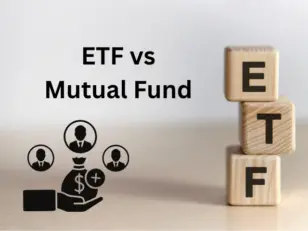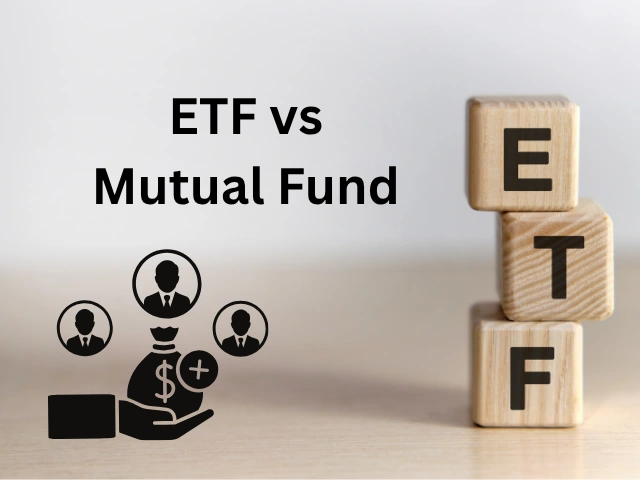Understand the difference between ETF vs mutual fund. Learn what ETFs are, how they work, and why investors consider them in the USA.
Investing in the stock market offers several options, and two of the most popular choices are ETFs and mutual funds. Both allow investors to diversify their portfolios, reduce risk, and gain exposure to multiple securities. However, they differ in structure, cost, and flexibility. Understanding ETF vs mutual fund is crucial for beginners and experienced investors alike. By comparing these two investment vehicles, you can make informed decisions that align with your financial goals, risk tolerance, and investment horizon. The USA market has thousands of ETFs and mutual funds available, ranging from equity-based, debt-based, sector-specific, and thematic funds. Choosing the right option requires knowledge of how each works and which suits your portfolio best.
What is an ETF?
An ETF (Exchange-Traded Fund) is a type of investment fund that trades on stock exchanges, similar to individual stocks. ETFs pool money from multiple investors to invest in a diversified portfolio of stocks, bonds, commodities, or other securities.
Key Features of ETFs:
- Traded Like Stocks – ETFs can be bought or sold anytime during market hours.
- Diversification – ETFs typically track an index or a sector, giving exposure to multiple assets.
- Lower Fees – Most ETFs have lower expense ratios compared to actively managed mutual funds.
- Transparency – ETFs disclose their holdings daily.
- Flexibility – Investors can use limit orders, stop-loss, or margin trading with ETFs.
ETFs have grown in popularity in the USA because they combine the diversification of mutual funds with the flexibility of stocks, making them suitable for both beginners and seasoned investors.
How ETFs Work
ETFs work by tracking a specific index, sector, or commodity. For example, an S&P 500 ETF aims to replicate the performance of the S&P 500 index by holding the same stocks in similar proportions.
ETF Mechanics:
- Creation and Redemption: Authorized participants create and redeem ETF shares in large blocks called “creation units” to keep the ETF price close to its net asset value (NAV).
- Buying and Selling: Investors can buy ETFs on exchanges just like individual stocks.
- Dividends: If the ETF holds dividend-paying stocks, investors may receive dividends, which can be reinvested or paid out.
- Expense Ratio: Most ETFs charge a low annual fee (expense ratio) for management and administration.
Because of their liquidity and cost-effectiveness, ETFs are ideal for investors who want market exposure without actively picking individual stocks or paying high management fees.
What is a Mutual Fund?
A mutual fund is a pooled investment vehicle where investors contribute money that is managed by professional fund managers. The fund invests in a diversified portfolio of stocks, bonds, or other securities based on the fund’s objective.
Mutual funds are one of the most popular investment options in the USA because they provide:
- Professional Management: Experienced managers select securities and monitor the portfolio.
- Diversification: Reduces risk by spreading investments across multiple assets.
- Accessibility: Beginners can invest with relatively small amounts.
- Variety of Options: Equity, debt, hybrid, index, and sector-specific funds.
Unlike ETFs, mutual fund shares are not traded on exchanges during the day. Instead, they are bought or sold at the Net Asset Value (NAV) calculated at the end of each trading day.
How Mutual Funds Work
Mutual funds pool money from multiple investors to create a larger fund that can buy a diversified portfolio of securities.
Key Mechanics:
- NAV Calculation: Mutual funds determine share price once daily after market close based on the value of the underlying assets.
- Buying and Selling: Investors purchase shares directly through the fund company or via brokers at the end-of-day NAV.
- Dividends and Capital Gains: Investors receive income from dividends and realized capital gains.
- Expense Ratio: Funds charge an annual fee to cover management and operational costs.
Mutual funds are ideal for investors who prefer a hands-off approach, allowing professional managers to make investment decisions while providing diversification and risk management.
Differences Between ETFs and Mutual Funds
While both ETFs and mutual funds provide access to diversified investments, they differ in several ways:
1. Trading Flexibility
- ETFs are traded like stocks on an exchange, allowing real-time buying and selling.
- Mutual funds are traded only at the end-of-day NAV.
2. Cost and Fees
- ETFs typically have lower expense ratios because many are passively managed.
- Mutual funds, especially actively managed ones, may have higher fees.
3. Transparency
- ETFs disclose holdings daily, making it easier to know what you own.
- Mutual funds may disclose holdings less frequently, often quarterly.
4. Minimum Investment
- ETFs allow fractional shares or low initial investments through brokers.
- Mutual funds may have higher minimum investment requirements ($500–$3,000 on average).
These differences make ETFs more suitable for active traders or investors seeking flexibility, while mutual funds appeal to those who prefer a more managed and hands-off approach.
5. Tax Efficiency
- ETFs are generally more tax-efficient because of the “in-kind creation and redemption” mechanism, which reduces capital gains distributions.
- Mutual funds may generate taxable capital gains when managers buy or sell securities within the fund.
6. Investment Strategy
- ETFs are often passively managed, tracking indexes or sectors.
- Mutual funds can be actively managed with fund managers making investment decisions to outperform the market.
7. Liquidity
- ETFs offer high intraday liquidity, making them suitable for tactical trades.
- Mutual funds are less liquid, as transactions occur only once per day.
8. Flexibility in Orders
- ETFs allow limit orders, stop-loss, and margin trading.
- Mutual funds are limited to market orders at end-of-day NAV.
These differences make ETFs ideal for cost-conscious or active traders, whereas mutual funds suit long-term investors preferring professional management.
Pros and Cons of ETFs
Pros
- Lower Costs: Many ETFs have low expense ratios.
- Trading Flexibility: Can buy/sell anytime during market hours.
- Tax Efficiency: Reduced capital gains taxes compared to mutual funds.
- Transparency: Holdings disclosed daily.
- Diversification: Provides exposure to multiple assets in a single investment.
Cons
- Trading Fees: Buying and selling ETFs may incur brokerage commissions (though many brokers now offer commission-free ETFs).
- Market Volatility: Prices fluctuate intraday, which may not suit conservative investors.
- Limited Active Management: Most ETFs are passively managed, potentially limiting high returns.
Pros and Cons of Mutual Funds
Pros
- Professional Management: Experienced fund managers make investment decisions.
- Diversification: Reduces risk by spreading investments across multiple securities.
- Ease of Investment: Simple for beginners; automatic reinvestment and SIP options.
- Variety: Offers equity, debt, hybrid, and sector-specific options.
- No Intraday Stress: Investors don’t need to monitor intraday price fluctuations.
Cons
- Higher Fees: Actively managed funds can have higher expense ratios.
- Less Tax-Efficient: Capital gains distributions may trigger taxes.
- Less Flexible: Trades only at end-of-day NAV; no intraday trading options.
- Minimum Investment Requirements: Some funds require higher initial investment amounts.
How to Choose Between ETF vs Mutual Fund
Choosing between an ETF and a mutual fund depends on your investment goals, risk tolerance, and trading style. Here are key factors to consider:
1. Investment Horizon
- Short-term / Active Trading: ETFs are better due to intraday trading flexibility.
- Long-term / Passive Investment: Mutual funds suit investors looking for professional management and long-term growth.
2. Cost Sensitivity
- ETFs usually have lower expense ratios and are more tax-efficient, making them suitable for cost-conscious investors.
- Mutual funds may be worth it if active management can generate higher returns despite higher fees.
3. Risk Tolerance
- ETFs can be volatile during market hours; suitable for moderate to high-risk investors.
- Mutual funds provide stability and diversification, suitable for conservative investors.
4. Trading Flexibility
- If you want the ability to place limit orders, stop-loss, or trade intraday, ETFs are ideal.
- Mutual funds are better for investors who prefer end-of-day NAV trades and a hands-off approach.
Tips for Beginners
- Start Small: Begin with low investment amounts to get comfortable.
- Diversify Portfolio: Combine ETFs and mutual funds to balance risk and returns.
- Use SIPs (Systematic Investment Plans): Automate mutual fund investments to ensure consistency.
- Research Before Investing: Check fund objectives, historical performance, fees, and manager reputation.
- Stay Patient: Both ETFs and mutual funds benefit from long-term investing. Avoid reacting to short-term market swings.
FAQs About ETFs and Mutual Funds
1. Can beginners invest in ETFs and mutual funds?
- Yes, both are beginner-friendly. ETFs offer flexibility, while mutual funds provide professional management.
2. Which is more tax-efficient?
- ETFs are generally more tax-efficient due to the in-kind creation/redemption mechanism.
3. Do ETFs pay dividends?
- Yes, dividends from the underlying securities may be distributed to ETF investors, often automatically reinvested.
4. Are mutual fund returns guaranteed?
- No, returns depend on market performance. Mutual funds reduce risk via diversification but cannot guarantee profits.
5. Can I combine ETFs and mutual funds in one portfolio?
- Absolutely. Combining both can provide flexibility, diversification, and balanced risk/return.
Conclusion
When comparing ETF vs mutual fund, there is no one-size-fits-all answer. Your choice depends on:
- Investment horizon
- Risk tolerance
- Trading style
- Cost sensitivity
Key Takeaways:
- ETFs are ideal for cost-conscious, active traders seeking flexibility and tax efficiency.
- Mutual funds are perfect for long-term investors seeking professional management and diversification.
- Combining both can help create a balanced, diversified portfolio.
- Research, patience, and consistency are essential for investment success.
By understanding the differences, pros, and cons, USA investors can make informed decisions between ETFs and mutual funds, ultimately achieving their financial goals with confidence.

